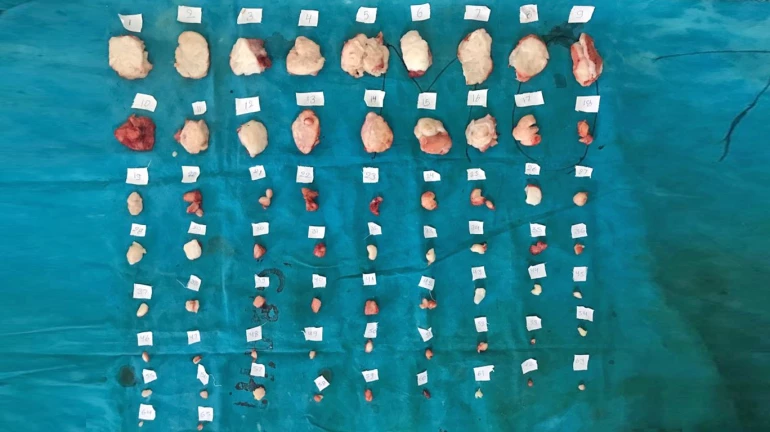
The number of women detected with fibroids in the uterus has increased now compared to the last five years. The surge in cases is attributed to factors such as women prioritising their careers over starting a family, delayed marriages, and pregnancies. Additionally, doctors mention that professional stress and changes in lifestyle also contribute to an uptick in fibroid cases. It is the need of the hour to consult the doctor without any delay and seek immediate treatment.
Uterine fibroids, also known as leiomyomas or myomas, are muscular tumours that can be found on a woman's uterus and are rarely cancerous. Women typically experience uterine fibroids during their child-bearing years, usually between the ages of 30 and 40. However, it is becoming more common for women aged 21-30 to develop fibroids as well. It is important to note that multiple fibroids can occur, starting as small as a seed and growing to the size of a melon. Not all women will experience symptoms, but the common signs include excessive bleeding during periods, pelvic pain, frequent urination, bladder pressure, rectum pain, lower back pain, constipation, bloating, prolonged periods lasting more than 7 days, blood clots, and bleeding outside of menstrual cycles. Uterine fibroids are not life-threatening, but they can cause discomfort and lead to fatigue due to the loss of red blood cells (anaemia) from heavy bleeding. Furthermore, women may also face depression, anxiety, stress, and panic. Consequently, many women opt for hysterectomies to address this issue. It is crucial not to ignore this condition and seek immediate attention. Don't hesitate to discuss this problem with your doctor and take action before any delays occur.
Dr Padma Srivastava, Consultant Obstetrician & Gynaecologist, Motherhood Hospitals, Lullanagar, Pune said, “A large number of women are unaware that they have fibroids. There is a 50% surge in fibroid cases now when compared to the last 5 years. The age group mostly affected is 30 years and above. Approximately, 25% of women coming in the OPD are complaining of heavy menses that are associated with fibroids. Some fibroids are detected when patients come for scans for pregnancy at the beginning of 1st trimester/ routine check-ups. We have seen 2-3 patients coming with fibroids during pregnancy in a week, and 4-6 such cases per month. The adolescent age group is also picking up with fibroids, where we are witnessing about 1-2 cases per month. So, overall, 200-250 patients per month are detected with fibroids. But many women suffer in silence and tend to face serious health consequences.”
Dr. Supriya Puranik, Director – 9M Fertility & Senior Consultant Obstetrics & Gynaecology, Ankura Hospital, Pune said: “Fibroids can affect women of all ages, but they are most commonly diagnosed in women between the ages of 30 and 40. They can also occur in women in their 20s and beyond, but the incidence tends to increase with age until menopause. It's essential to note that fibroids can occur at any age, and some women may experience them earlier or later in life. The Possible Causes of Fibroids and the exact causes of fibroids remain unclear, but various factors may contribute to their development. These factors can include:
a. Hormonal Imbalances: Estrogen and progesterone, hormones that regulate the menstrual cycle, are thought to play a role in fibroid growth. Fibroids tend to grow during the reproductive years when hormone levels are at their highest and often shrink after menopause when hormone levels decline.
b. Genetic Predisposition: There may be a genetic component to fibroid development, as women with a family history of fibroids are more likely to develop them.
c. Race and Ethnicity: Research suggests that fibroids are more prevalent in African-American women compared to women of other racial and ethnic backgrounds.
d. Lifestyle and Diet: Some studies have suggested that factors such as obesity and a diet high in red meat and low in fruits and vegetables may increase the risk of fibroids.
e. Reproductive History: Women who have never given birth or had their first child at a later age may have an increased risk of developing fibroids.
f. Other Factors: Other factors, such as insulin-like growth factors, inflammation, and vascular growth factors, may also play a role in fibroid development.
It's important to note that while these factors are associated with fibroids, the exact interplay between them remains complex and requires further research.”
“Fibroids are non-cancerous and naturally decrease in size after menopause. To address problematic fibroids and enhance the quality of life, various methods can be employed, including the use of a progestin-releasing intrauterine device (IUD), medication, laparoscopic or robotic myomectomy, as well as traditional surgical procedures like hysterectomy and abdominal myomectomy,” concluded Dr Padma.





